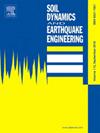Numerical investigation of cyclic load effects on geogrid-encased stone columns using a 3D coupled method
IF 4.2
2区 工程技术
Q1 ENGINEERING, GEOLOGICAL
引用次数: 0
Abstract
Geosynthetic-encased stone columns (GESCs) represent an efficient and cost-effective solution for enhancing weak soil foundations. The deformation and load-bearing mechanisms of GESC-improved foundations under traffic flow are complicated due to substantial particle movements and soil disruption. A three-dimensional discrete-continuum coupled numerical model was proposed in this study to investigate the cyclic behavior of GESC-improved soft soil. The reliability and accuracy of proposed model was validated through experimental data. The effect of cyclic loads, bearing stratum, and geogrid encasement was investigated. Microscopic investigation of particle movement, contact force distribution, and stress transfer mechanism was performed. The vertical loads transferred from the column to the surrounding soil with the interaction effect between the aggregates and the soil. The stress concentration ratio decreased with the increase in depth. The geogrid encasement facilitated the load transfer process by effectively confining the particles and enhancing the column stiffness. The particles in the low segment of floating column exhibited large downward displacements and punching deformation. The geogrid encasement and cyclic loads contributed to enhanced compaction and coordination number of the aggregates.
求助全文
约1分钟内获得全文
求助全文
来源期刊

Soil Dynamics and Earthquake Engineering
工程技术-地球科学综合
CiteScore
7.50
自引率
15.00%
发文量
446
审稿时长
8 months
期刊介绍:
The journal aims to encourage and enhance the role of mechanics and other disciplines as they relate to earthquake engineering by providing opportunities for the publication of the work of applied mathematicians, engineers and other applied scientists involved in solving problems closely related to the field of earthquake engineering and geotechnical earthquake engineering.
Emphasis is placed on new concepts and techniques, but case histories will also be published if they enhance the presentation and understanding of new technical concepts.
 求助内容:
求助内容: 应助结果提醒方式:
应助结果提醒方式:


